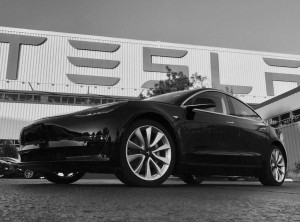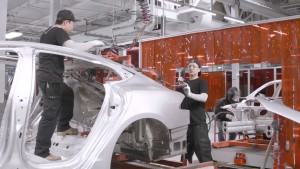Tesla’s ongoing growing pains moving from a low-volume to mass market manufacturer continue as the EV maker had to shut down its production on the Model 3 for a week last month.
The company temporarily suspended production at its Fremont, California plant as well as at its Gigafactory in Nevada, Feb. 20-24, to adjust equipment to improve automation and increase production rates.
The automaker has been under fire for continually missing deadlines for increasing the production run rates at its plant. The goal is ultimately to produce 500,000 vehicles annually, including 100,000 Model S and X vehicles. The current rate is significantly lower than that.
Tesla said the stoppage was planned, claiming it was “normal and common” for increases in output when a company is in the ramp-up phase of production for a new vehicle.
(Tesla loses big money in 2017: $1.96B. Click Herefor the story.)

A new Model 3 in front of Tesla's Fremont, California plant, which began producing the new entry-level model last year.
“Our Model 3 production plan includes periods of planned downtime in both Fremont and Gigafactory 1. These periods are used to improve automation and systematically address bottlenecks in order to increase production rates,” a Tesla spokesperson said in an email.
The company did not provide specifics about the production upgrade, Reuters reported, but said there could be more periods of downtime in the weeks ahead.
Productions rates have been a bit of moving target with the Model 3. Last month, Tesla said in a shareholder note that it continues to target weekly Model 3 production rates of 2,500 by the end of the first quarter and 5,000 by the end of the second quarter.
(Click Here for more about Model 3 production delays.)
The company, however, hedged its bets in the same note, saying, “our prior experience on the Model 3 ramp has demonstrated the difficulty of accurately forecasting specific production rates at specific points in time.
“We are taking many actions to systematically address bottlenecks and add capacity in places like the battery module line where we have experienced constraints, and these actions should result in our production rate significantly increasing during the rest of (the first quarter) and through (the second quarter),” the company said in the note.
(To see the first-ever bullet-proof Tesla Model S, Click Here.)
In the fourth quarter, Tesla said it delivered 28,425 Model S and Model X vehicles and 1,542 Model 3 vehicles, totaling 29,967 deliveries. Tesla did deliver more than 100,000 vehicles overall in 2017.


Elon, the answer is v e r y s i m p l e!
1) Find out who the plant manager of Ford’s Kentucky Truck is (F Series, Expedition, Navigator).
2) Make him an offer he can’t refuse.
3) Do what he says!